Need help? We're here to assist you!
Thank You for Enquiry, we will contact you soon!
Close
The Class 8 is an important year in a student’s life and Science is one of the subjects that require dedication, hard work, and practice. It’s a subject where you can score well if you are well-versed with the concepts, remember the important formulas and solving methods, and have done an ample amount of practice. Worry not! Home Revise is here to make your Class 8 journey even easier. It’s essential for students to have the right study material and notes to prepare for their board examinations, and through Home Revise, you can cover all the fundamental topics in the subject and the complete NCERT Class 8 Science Book syllabus.

Exercise Questions
1. Suppose you are in a dark room. Can you see objects in the room? Can you see objects outside the room? Explain.
Soln:
If a person is inside a room where there is no light, it is then impossible to see the object inside the room, but the object outside the room can be seen easily.
When light falls on the eyes after reflecting from the object, it becomes visible. If the room is dark, then the object which is in the room reflects no light. Hence, the person is not able to see the objects in the room where there is no light.
2. Differentiate between regular and diffused reflection. Does diffused reflection mean the failure of the laws of reflection?
Soln:
| Sl.No | Regular Reflection | Diffused Reflection |
| 1. | It occurs when the surface is smooth. | It occurs when the surface is rough. |
| 2. | Reflected rays move in a particular direction. | Reflected rays scatter in random directions. |
| Example: Reflection by the plane mirror | Example: Reflection by the road surface. |
The laws of reflection have not failed because each ray obeys the law of reflection. All the reflected rays are parallel to each other, whereas in diffused reflection, the rays aren’t parallel to the incident rays.
3. Mention against each of the following whether regular or diffused reflection will take place when a beam of light strikes. Justify your answer in each case.
(a) Polished wooden table
(b) Chalk powder
(c) Cardboard surface
(d) Marble floor with water spread over it
(e) Mirror
(f) Piece of paper
Soln:
a) The wooden table that has a polished surface – Regular reflection
A surface that has been recently polished can be a good example of a smooth surface. The polished wooden table has a smooth surface.
b) White chalk powder that is used in school – Diffused reflection
Chalk powder spread on a surface is an example of an irregular surface because it is rough. Therefore, the diffused reflection will appear from chalk powder.
c) Cardboard surface – Diffused reflection
The surface of the cardboard is a kind of irregular surface. Hence, the diffused reflection will take place from a cardboard surface.
d) Marble floor – Regular reflection
A marble floor can be a good example of a surface that is regular. Since water makes the ceramic glossy, the reflections that are regular occur on this surface.
e) Mirror – Regular reflection
A mirror has a very smooth surface; hence it gives a regular reflection.
f) Piece of paper – Diffused reflection
Although a piece of paper may look smooth, it has many irregularities on its surface. Due to this reason, it will give a diffused reflection.
4. State the laws of reflection.
Soln:
The law of reflection states that:
a) The angle of reflection and the angle of incidence are always equal to one another.
b) The reflected ray, the incident ray, and the normal to the reflective surface at the point of incidence all come on the same plane.
5. Describe an activity to show that the incident ray, the reflected ray and the normal at the point of incidence lie in the same plane.
Soln:
On a table, place a plane mirror perpendicular to the plane of the table. Make a small hole in a piece of paper and hold it perpendicular to the plane of the table. Try to do this experiment in a dark room. Take one more piece of paper and place it on the table so that it makes contact with the mirror. Draw a line perpendicular to the mirror on the piece of paper which is on the table. Now, beam light rays with the help of a torch through the small hole, such that the beam of light hits the normal at the bottom of the mirror. The ray of light will be reflected in the light rays from the hole incident on the mirror. Looking at the piece of paper on the table, we can easily show that the incident ray, the normal line and the reflected ray at the point of incidence lie in the same plane.
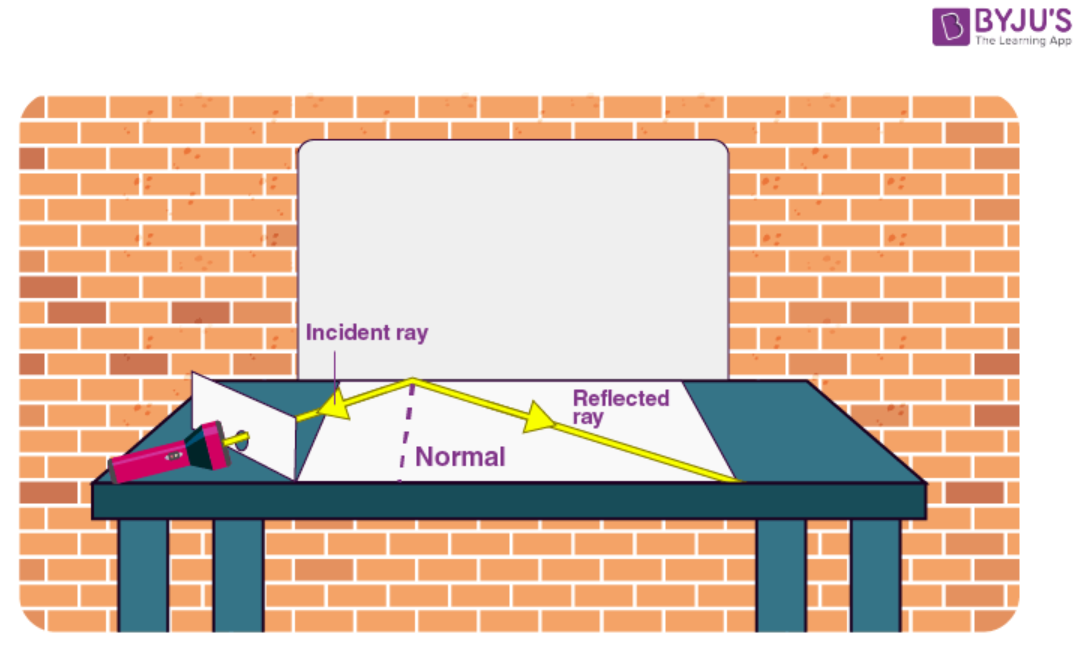
6. Fill in the blanks in the following.
(a) A person 1 m in front of a plane mirror seems to be _______________ m away from his image.
(b) If you touch your ____________ ear with your right hand in front of a plane mirror, it will be seen in the mirror that your right ear is touched with your ____________.
(c) The size of the pupil becomes ____________ when you see in dim light.
(d) Night birds have ____________ cones than rods in their eyes.
Soln:
(a) A person 1 m in front of a plane mirror seems to be 2 m away from his image.
(b) If you touch your left ear with your right hand in front of a plane mirror, it will be seen in the mirror that your right ear is touched with your left hand.
(c) The size of the pupil becomes large when you see in dim light.
(d) Night birds have fewer cones than rods in their eyes.
Choose the correct option in Questions 7 – 8
7. The angle of incidence is ________ equal to the angle of reflection.
(a) Always
(b) Sometimes
(c) Under special conditions
(d) Never
Soln:
The answer is (a) Always
8. Image formed by a plane mirror is
(a) virtual, behind the mirror and enlarged.
(b) virtual, behind the mirror and of the same size as the object.
(c) real at the surface of the mirror and enlarged.
(d) real, behind the mirror and of the same size as the object.
Soln:
The answer is (b) virtual, behind the mirror and of the same size as the object.
9. Describe the construction of a kaleidoscope.
Soln:
The construction of a kaleidoscope is detailed below:
Take three rectangular mirror strips of dimensions 15 cm x 4 cm (l x b) and join them together to form a prism. A prism is fixed into a circular cardboard tube. The circular cardboard tube should be slightly longer than the prism. This circular tube is now closed at one end with a cardboard disc. This disc has a hole through which we can see. At the other end of the circular tube, a plane glass plate is fixed. It is important that this glass plate touches the prism mirrors. On this glass plate, several small and broken pieces of coloured glass are placed. This end is now closed by a round glass plate, allowing enough space for the coloured glass pieces to move.
10. Draw a labelled sketch of the human eye.
Soln:
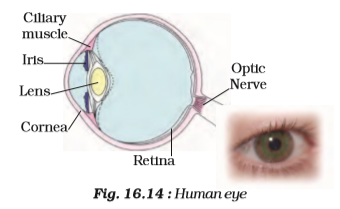
11. Gurmit wanted to perform Activity 16.8 using a laser torch. Her teacher advised her not to do so. Can you explain the basis of the teacher’s advice?
Soln:
Gurmit’s teacher advised her not to do so because the intensity of the laser light is very high, and it is harmful to the human eyes. It can cause damage to the retina and leads to blindness. Hence, it is advisable not to look at a laser beam directly.
12. Explain how you can take care of your eyes.
Soln:
The following points help a person to take care of his eyes:
a) Reading should not be done in bright light as well as in dim light.
b) We should visit an eye specialist at regular intervals of time.
c) If any small insects or dust particles enter our eyes, do not rub them but clean them immediately with cold water.
d) We should avoid direct exposure of our eyes to sunlight.
e) While reading, there should be a distance of at least 25 cm between the eyes and the book.
13. What is the angle of incidence of a ray if the reflected ray is at an angle of 90° to the incident ray?
Soln:
If the reflected ray is at the angle of 90o to the incident ray, then the angle of incidence is 45o . According to the law of reflection, the angle of incidence and the angle of reflection are equal. Therefore, both the angle of incidence and the angle of reflection are 90/2 = 45o .
14. How many images of a candle will be formed if it is placed between two parallel plane mirrors separated by 40 cm?
Soln:
If a candle is placed between two parallel plane mirrors separated by 40 cm, then multiple and infinite images will be formed due to the multiple reflections between the mirrors. Infinite numbers of images are formed when two mirrors are placed parallel to each other.
15. Two mirrors meet at right angles. A ray of light is incident on one at an angle of 30° as shown in Fig. 16.19. Draw the reflected ray from the second mirror.
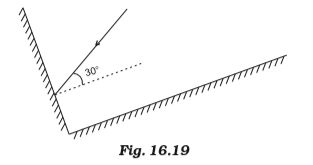
Soln:
The first law of reflection is used to obtain the path of reflected light.
It can be observed that the given ray of light will reflect from the second mirror at an angle of 60° .
The incident ray OA reflects at point O
Since Angle of Reflection = Angle of Incidence
OO’ makes an angle of 300
with the normal of the first mirror
Now, drawing normal at O’
The two normals intersect at 900
angle
And applying angle sum property in △ OXO’
We get
The angle of Incidence in 2nd
mirror = 600
Applying the law of reflection in 2nd
mirror,
We get the below figure.
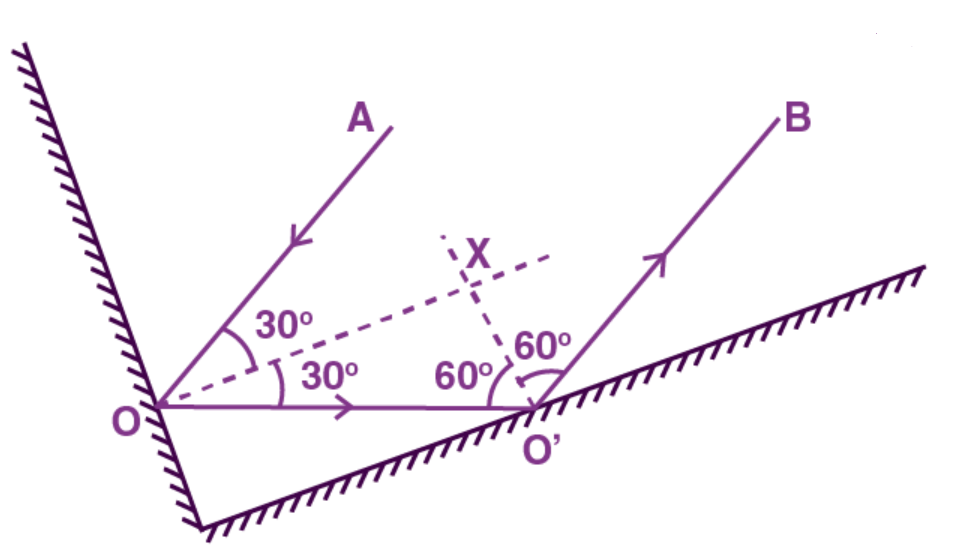
16. Boojho stands at A just on the side of a plane mirror, as shown in Fig. 16.20. Can he see himself in the mirror? Also, can he see the image of objects situated at P, Q and R?
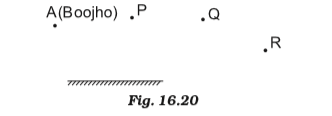
Soln:
Boojho cannot see his image because the reflected ray won’t reach his eyes. He can see the image of objects situated at P and Q because the rays coming from P and Q get reflected by the mirror and reach his eyes. Boojho can’t see the image of objects situated at R because the ray from object R does not get reflected.
17. (a) Find out the position of the image of an object situated at A in the plane mirror (Fig. 16.21).
(b) Can Paheli at B see this image?
(c) Can Boojho at C see this image?
(d) When Paheli moves from B to C, where does the image of A move?

Soln:

a) Image of the object placed at A is formed behind the mirror. The distance of the image from the mirror is equal to the distance of A from the mirror.
b) Yes, Paheli at B can see this image.
c) Yes, Boojho at C can see this image.
d) Image of the object at A will not move. It will remain in the same position when Paheli moves from B to C.